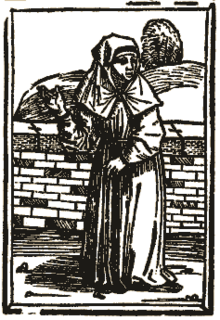Aegidienhof Lübeck
The Aegidienhof in Lübeck is one of the largest social housing projects in Schleswig-Holstein .
Goal setting
The project tries not to alienate young and old, people without and with disabilities, single people and families, living and working from one another, but rather to bring them together in a new urban mix.
Citizens from Lübeck and the surrounding area formed a building community at the end of 1999 without the involvement of a major investor in order to preserve a piece of Lübeck's old town and bring it back to life. Through the purchase and careful renovation of the building and cultural-historical complex around the Aegidienhof, the social welfare office (until 1997) created a project in which people can live and find their jobs again.
history
The complex consists of 12 buildings. It encompasses a block of St.-Annen-Straße between Stavenstraße and Weberstraße , which has been characterized by communal and social use for centuries and which reflects the church and social history of the city.
Aegidia Convention
Shortly after the construction of the Aegidienkirche , a beginner's convent was founded opposite its choir on the other side of St.-Annen-Strasse around 1270 . The second big city fire in 1276 brought the change from half-timbered to brick construction in Lübeck . Four years later the Aegidienviertel was parceled out. The first documentary mention of today's property in 1288 took place in Aegidienstraße 5, today house 2. Nine years later the Aegidien-Konvent was built in today's St.-Annen-Straße 3. In 1301 the Beguines moved to the Aegidien convent. The building had a house chapel on the ground floor, the location of which is still recognizable today through unusually large window openings, a walled-up pointed arch portal and remains of late Gothic wall paintings uncovered in 2002.
Michaeliskonvent
In 1397 Berthold Segeberg bought the property on the corner of Weberstrasse. to use it for a poor house. The community of “wool sisters”, women who submitted to a monastery-like rule, was called the Segeberg or Michaelis Convent.
The Michaelishaus, today St.-Annen-Straße 5, was built in 1450. In addition, the "woolly sisters" of the Michaelis monastery received a new order, and the sisters from living together (the female counterpart of the brothers from living together found a home here. Thirteen years later, the Michaelis Chapel, which no longer exists, was built on the corner plot behind this wall. Remarkable and of unique importance for the transmission of the Middle Low German language are the approximately 100 volumes that have been preserved in her library, which are now in the city library (Lübeck) . Three more volumes were in 1871 via Ludwig Heinrich Kunhardt in the Hamburg city library (today State and University Library Hamburg ).
In 1531, Johann Bugenhagen brought the Reformation to Lübeck and the convent was dissolved. The buildings initially served as a retirement home.
In the St. Anne's Museum there are two altar shrines that used to stand in one of the two convents: the fourteen helper altar , a winged altar from around 1500, and a smaller Anne shrine from the end of the 15th or beginning of the 16th century, as well as a panel from 1480/90, acquired from the art trade in 1999, showing a Madonna with a praying donor (Councilor Hinrich Lipperade ) and attributed to Hermen Rode .
Orphanage
From 1556/57, the house at St.-Annen-Straße 5 (until then Michaelis / Segeberg convent) took in orphans. The house at Weberstrasse 1-1b was built as a new orphanage. In 1810 the orphans moved to the Lübeck orphanage at the Domkirchhof .
Poor house and social welfare office
In the years 1845/46 a new overall conception of the facility for poor and homeless with the office for institutions and workshops followed. A year later, the inspector's house in St.-Annen-Strasse 5b was rebuilt. In addition, the old Aegidien- / Beginenkonvent was finally dissolved and a voluntary workhouse was founded. In 1890, the voluntary workhouse on Stavenstrasse was rebuilt in the Wilhelminian style after larger parts of the former Aegidien / Beguines convent were demolished, and a staircase in St.-Annen-Str. 5a and the two gabled houses in St.-Annen-Straße 3–5 were converted.
In 1929 the workshop building on the south-eastern border of the Aegidienhof in Weberstr. 1f built. After the Second World War, in 1950, the area was converted and used as a social welfare office . In 1998 the social welfare office moved out, followed by the development of the project for new living and working in the Aegidienhof. In the following two years the area was renovated and modernized. The first new residents moved into the Aegidienhof in 2000.
literature
- Rafael Feismann: The memory book of the St. Michaelis convent in Lübeck. Two manuscripts from the years 1463 and 1498. Lübeck: Schmidt-Römhild 1994 (publications on the history of the Hanseatic city of Lübeck, series B, vol. 24).
- Johann Peter Wurm: The foundation of the Michaeliskonvent of the sisters of common life in Lübeck. In: Zeitschrift des Verein für Lübeckische Geschichte und Altertumskunde 85 (2005), pp. 25–53.
Web links
- Official website of the Aegidienhof in Lübeck
- Worth knowing about the Aegidienhof
- Werkstatt-Stadt (Internet platform, examples from nationwide urban development practice)
Individual evidence
- ^ Paul Hagen : The German theological manuscripts of the Lubeck city library. Lübeck: Schmidt-Römhild 1922 (Publications of the City Library of the Free and Hanseatic City of Lübeck 1,2), P. VII ( digitized version ).
- ↑ See Hildegard Vogeler : The Altars of the St. Annen Museum. Lübeck 1993, pp. 25 and 83; Uwe Albrecht , Jörg Rosenfeld and Christiane Saumweber: Corpus of medieval wood sculpture and panel painting in Schleswig-Holstein , Volume I: Hanseatic City of Lübeck, St. Annen Museum. Kiel: Ludwig, 2005. ISBN 3-933598-75-3 , No. 83.88.126
Coordinates: 53 ° 51 ′ 47.7 " N , 10 ° 41 ′ 26" E



